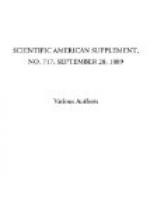It is not too much to say that a boy turning a handle could, if his energy were properly directed, produce quite as much real light as is produced by all this mass of mechanism and consumption of material. There might, perhaps, be something contrary to the laws of nature in thus hoping to get and utilize some specific kind of radiation without the rest, but Lord Rayleigh has shown in a short communication to the British Association at York that it is not so, and that, therefore, we have a right to try to do it.
We do not yet know how, it is true, but it is one of the things we have got to learn.
Any one looking at a common glow-worm must be struck with the fact that not by ordinary combustion, nor yet on the steam engine and dynamo principle, is that easy light produced. Very little waste radiation is there from phosphorescent things in general. Light of the kind able to affect the retina is directly emitted; and for this, for even a large supply of this, a modicum of energy suffices.
Solar radiation consists of waves of all sizes, it is true; but then solar radiation has innumerable things to do besides making things visible. The whole of its energy is useful. In artificial lighting nothing but light is desired; when heat is wanted it is best obtained separately by combustion. And so soon as we clearly recognize that light is an electric vibration, so soon shall we begin to beat about for some mode of exciting and maintaining an electrical vibration of any required degree of rapidity. When this has been accomplished the problem of artificial lighting will have been solved.
* * * * *
ON PURIFICATION OF AIR BY OZONE—WITH AN ACCOUNT OF A NEW METHOD.[1]
[Footnote 1: Paper read
in Section C, Domestic Health, at the
Hastings Health Congress,
on Friday, May 3, 1889.]
By Dr. B. W. RICHARDSON.
During the time when I was engaged in my preliminary medical studies—for I never admit to this day of being anything less than a medical student—the substance called ozone became the topic of much conversation and speculation. I cannot say that ozone was a discovery of that date, for in the early part of the century Von Marum had observed that when electrical discharges were made through oxygen in a glass cylinder inverted over water, the water rose in the cylinder as if something had either been taken away from the gas, or as if the gas itself had been condensed, and was therefore occupying a smaller space. It had also been observed by many electricians that during a passage of the electric spark through air or oxygen, there was a peculiar emanation or odor which some compared to fresh sea air, others to the air after a thunderstorm, when the sky has become very clear, the firmament blue, and the stars, if visible, extremely bright.




